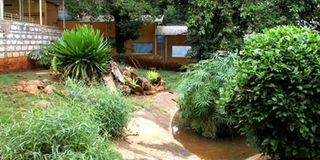Sunday morning at Nairobi’s near-world-class snake park

The botanical garden at the Snake Park. PHOTO | JOHN FOX
What you need to know:
- Despite, probably because of, many people’s aversion to snakes, the park has always attracted a lot of interest
- But the place badly needs a wash and brush-up. Someone should clean and polish the glass of the showcases. And someone should give a lick of paint, here and there
I was standing on a secluded river bank in Samburu, doing what the English used to call “spending a penny”. I was admiring the view across the river — until I looked down and saw a huge python coiled in the grass about a metre from my feet.
It was the quickest penny I have ever spent.
I’m remembering this close encounter because I was persuaded to go to the snake park last Sunday morning — the well known one, at the National Museum.
Snakes don’t have much of a personality, do they? Well, even if they do, they don’t show it ... Mind you, one of my favourite Disney characters is the sly and sinister Sir Hiss, in the classic film version of Robin Hood. And there is also the smooth-talking Kaa in Disney’s Jungle Book.
But, in real life, snakes don’t show their feelings much — until they strike, or get a crush on you, like a python. Otherwise, they lie listless, hiding under a boulder, hanging from a branch, coiled in the grass; or staying self-knotted in the corners of their glass-fronted cases in the snake parks, their black beads of eyes telling you nothing.
We, ourselves, took a few snakes to the museum — dead ones. When we moved into our first house along Gitanga Road, we found the garden untended and overgrown. We also found a few snakes. Mwangi, the gardener, killed two of them. Each time we took them to the museum for identification — a house snake and a vine snake — we were told that they were harmless. They also told us that the only venomous snakes in Nairobi are spitting cobras.
So we told Mwangi not to kill any more snakes in the garden. Then, when we came back from a holiday, we found he had killed another one — a rather squat snake with black and amber bands. I was rather taken to it because those were my old school colours. So I was cross with Mwangi for killing it ... Until the museum told us its bite was very poisonous.
I was hoping to see a live version of that black and amber snake when I visited the park last Sunday. It wasn’t there. But there were many others: sand boas, Gaboon vipers, Mount Kenya bush vipers, carpet vipers, brown house snakes, black mambas, garter snakes, puff adders, spitting cobras and, oh yes, rock pythons.
The place has an interesting history — well told on the National Museum’s website. It was started back in January 1961 not only to entertain visitors but also to provide a research facility. It was set in a botanical garden.
Despite, probably because of, many people’s aversion to snakes, the park has always attracted a lot of interest. But in 2008 it went through a major face-lift. And a more interactive programme was initiated with such things as an octopus exhibition, touchy-feely sessions with harmless reptiles and amphibians, and feeding of crocodiles with live fish.
And the aquaria were greatly improved, with some art work and more dramatic lighting, to better show off the fascinating variety of fish — from the lugubrious catfish to the brightly coloured creatures that enliven the coral reefs at the Coast.
“It is your world-class tourist destination!” the website boasts. Well, no, it really isn’t. Yes, the park has a good collection of reptiles and fish. The inner gardens are nice. There are a few stunted trees with snakes in them. There are concreted pools where crocodiles and alligators lounge menacingly. There are tortoises and turtles, eating left-out cabbage leaves.
But the place badly needs a wash and brush-up. Someone should clean and polish the glass of the showcases. And someone should give a lick of paint, here and there.
There were only five of us there that late Sunday morning: the others were a couple with their little girl — and a lone Japanese tourist with his camera.
“I thought there would be more here on a Sunday,” I said to the attendant on my way out.
“But it’s too early yet,” he replied. “They will come – many people will come.”
“Oh, they must be having a Sunday lie-in.”
“No, they are in church. Then they will come.”
Of course, this is Kenya.
And there was another pleasant interchange as I started my engine in the museum’s car park. One of the security guys tapped on the window. I wound it down.
“Is your car OK?” he asked.
“Yes, it’s fine, thank you.”
“Well, can you give me something for looking after it?”
“Isn’t that what you are paid to do?”
“Yes, but there is also something called a tip!”
John Fox is Managing Director, iDC





